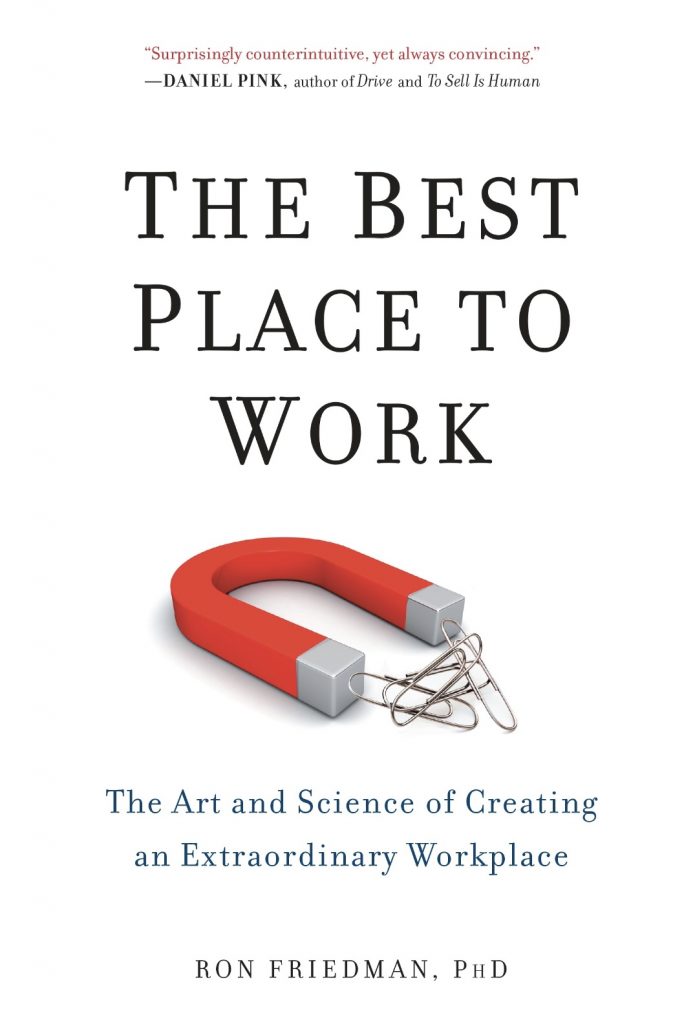Key Quote:
“Great workplaces instill a sense of pride in their employees. Some ways to build a sense of pride are finding ways to recognize each and every employee for their contributions, explain company history in a coherent narrative, and build a bridge between your workplace and the greater good. This sense of pride ultimately influences employees to stay at the company” (pp. 264-266). — Ron Friedman
Key Points and Concepts
Great Workplaces Address Employees’ Psychological Needs
Excellent workplaces strive to make their employees happy. When we are happy, we are “better at connecting with others, seeing the big picture, and generating creative ideas” (p. 98). The problem is that we tend to not stay happy for very long. Even after signing a new client or getting a raise, we tend to go back to a baseline level of happiness. Some tactics that help workplaces keep employees happier for longer are giving small frequent gifts (rather than large, infrequent ones), varying the work schedule to help keep people emotionally engaged and refreshed, and rewarding workers with experiences rather than objects (pp. 84-89).
Studies show that employees are more productive and happier when they have a view of the outdoors, are not sitting with their backs exposed, and have plants in the office (p. 35).
Employees are most engaged when they enter a state of “flow”, which describes when “we get fully immersed, losing track of time and place” (pp. 168-169). In order to experience flow, we need to continually “face challenges that either match or slightly exceed our current ability” (p. 169).
When conflicts arise, great workplaces encourage their employees to incorporate “relationship-building statements” to make mediation with clients and coworkers more productive. These statements help replace fear and anxiety in the relationship with trust and confidence. They are represented by the acronym PEARLS:
• Partnership: “I really want to work on this with you.”; “I bet we can figure this out together.”
• Empathy: “I can feel your enthusiasm as you talk.”; “I can hear your concern.”
• Acknowledgement: “You clearly put a lot of work into this.”; “You invested in this, and it shows.”
• Respect: “I’ve always appreciated your creativity.”; “There’s no doubt you know a lot about this.”
• Legitimation: “This would be hard for anyone.”; “Who wouldn’t be worried about something like this?”
• Support: “I’d like to help you with this.”; “I want to see you succeed.” (pp. 189-190).
Increasing Autonomy in the Workplace
• Successful leaders tap into how to motivate employees to be more committed to their work. Most employees are more engaged with their work when their supervisor gives them the flexibility and control to decide when and how they will complete tasks. Below are some behavioral techniques on how to give employees autonomy:
• One way managers empower workers is by defining “the outcome, not the process” (p. 146). In other words, the manager defines the end goals of the project, but allows the employees to determine a path for getting there.
• Another way managers increase autonomy is minimizing the focus on rewards. When managers reward employees for staying late with paid overtime or a free dinner, workers feel that they were forced to do the work and view their work as a means to an end. Meanwhile, when managers let success on the tasks serve as its own reward, and present an unexpected appreciative reward later, employees feel more focused on the task and intrinsically motivated.
• A third way managers increase autonomy is by approaching conversations regarding how to accomplish a task with open-ended questions. This provides an opportunity for employees to collaborate and take ownership for the project.
• There are also two ways that managers can mitigate employees’ feelings of powerlessness on projects that have strict requirements and deadlines. First, acknowledge negative feelings that employees express with phrases that mirror their emotions such as, “You’re feeling frustrated” or “This project is complicated” (p. 148). Mirroring helps make the employee feel understood, which reduces their frustration and helpless feelings. A second way is to provide a meaningful rationale regarding why a certain project, or path for completing the project, is necessary. Although the workers might still feel frustrated, they will understand why the project must be done in that manner and be more invested in completing the task well.
Excellent Workplaces Address the Limits of The Mind and Body
Studies show that when facing a difficult problem, being able to detach from the issue at hand actually helps make better decisions. Friedman describes detaching as moving from a “conscious” to “unconscious” mindset (p. 56). The conscious mind is “limited in capacity”: it can only process a few pieces of information at once and has trouble seeing the forest from within the trees, which leads to too much focus on small details at the expense of the big picture. Meanwhile, the unconscious mind can process complex information and simultaneously keep the big picture in mind, which leads to more creative solutions.
• Exceptional workplaces help their employees tap into their unconscious mindset by incorporating ‘playtime.’ Some examples of this are Twitter’s climbing wall, Zynga’s arcades, and Google’s volleyball courts (p. 59). Employees should feel comfortable to occasionally incorporate some playtime into their workday, especially when facing a difficult decision.
• Friedman suggests that workplaces should consider longer lunches to provide workers time to exercise. Studies show that life is more stressful than ever, resulting in depressing our mood and limiting the amount of information that we can process. Exercise can reduce our stress levels, resulting in better interactions (and thus relationships) with co-workers, increased productivity, and elevated creativity. Friedman argues that workplaces should consider longer lunches to provide workers time to get in some exercise in the middle of the day.
• Because we “have a biological need for rest that is no less pressing than our biological need for food or water,” napping should be allowed in the workplace. Most people replace their needed nap with a trip to a Starbucks, which takes the same amount of time and is less effective in recharging the body. Unlike coffee, naps can boost productivity, increase alertness, quicken motor reflexes, raise accuracy, strengthen stamina, elevate mood, lower stress, promote weight loss, bolster memory, improve decision-making, and more. Some companies, including Yahoo!, Time Warner, and Nike are investing in naptime for employees (p. 70).
How to Attract and Retain Top Performers
• Recognizing people’s strong attraction to flexibility is important in retaining talented employees. After a certain income level (approximately $80,000), employees value a flexible schedule more than a raise.
• The best workplaces find ways to allow employees the autonomy to take care of their family needs, arguing that, “we live in a world in which it is acceptable for work to interrupt personal time. And yet we’re not as comfortable when personal time interrupts work” (p. 273). The best workplaces realize that this truth ultimately hurts employee morale and productivity.
• Workplaces should rely on its best current employees to identify and recruit future coworkers from their network of contacts (p. 246). The reality is that the best employees are rarely searching for jobs. Therefore, current employees should take responsibility for recruiting talent.
• The best companies find ways to evaluate a job candidate’s ability rather than appearance. Many companies inadvertently become impressed (or unimpressed) by the way a candidate looks or dresses. A good way to avoid this trap is by creating a “blind audition”, in which when the candidates submit work for evaluation, the recruiter removes names from the documents so that other employees in the firm can judge the work based on merit alone. This process will result in more qualified hires (pp. 224-228).
• Great workplaces instill a sense of pride in their employees. Some ways to build a sense of pride are finding ways to recognize each and every employee for their contributions, explain company history in a coherent narrative, and build a bridge between your workplace and the greater good (pp. 264-266). This sense of pride ultimately influences employees to stay at the company.
Friedman, R. (2014). The Best Place to Work: The Art and Science of Creating an Extraordinary Workplace. New York: Penguin Group.

When conflicts arise, great workplaces encourage their employees to incorporate “relationship-building statements” to make mediation with clients and coworkers more productive. These statements help replace fear and anxiety in the relationship with trust and confidence.
Great workplaces instill a sense of pride in their employees. Some ways to build a sense of pride are finding ways to recognize each and every employee for their contributions, explain company history in a coherent narrative, and build a bridge between your workplace and the greater good. This sense of pride ultimately influences employees to stay at the company.
